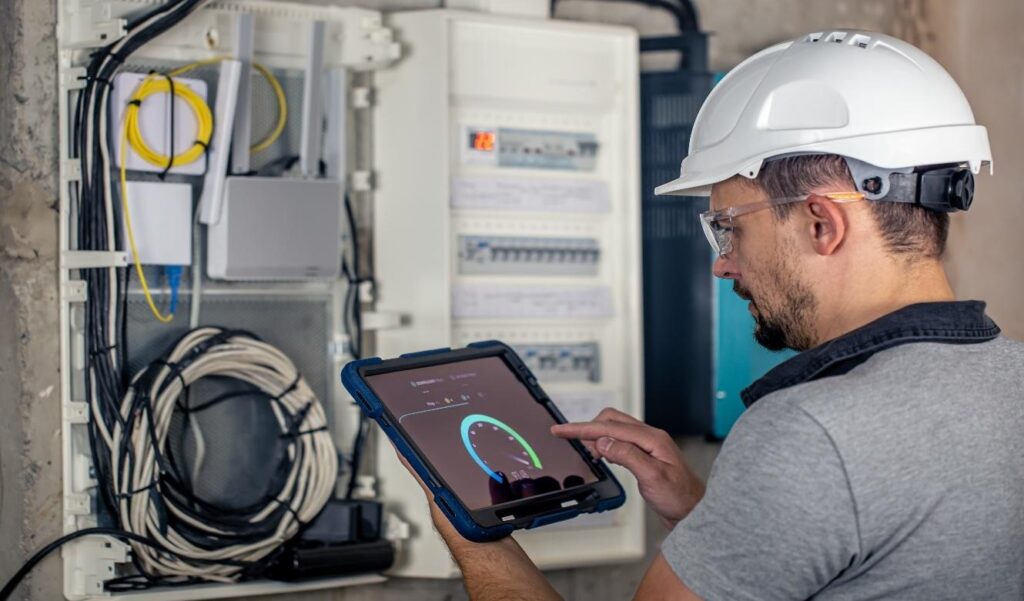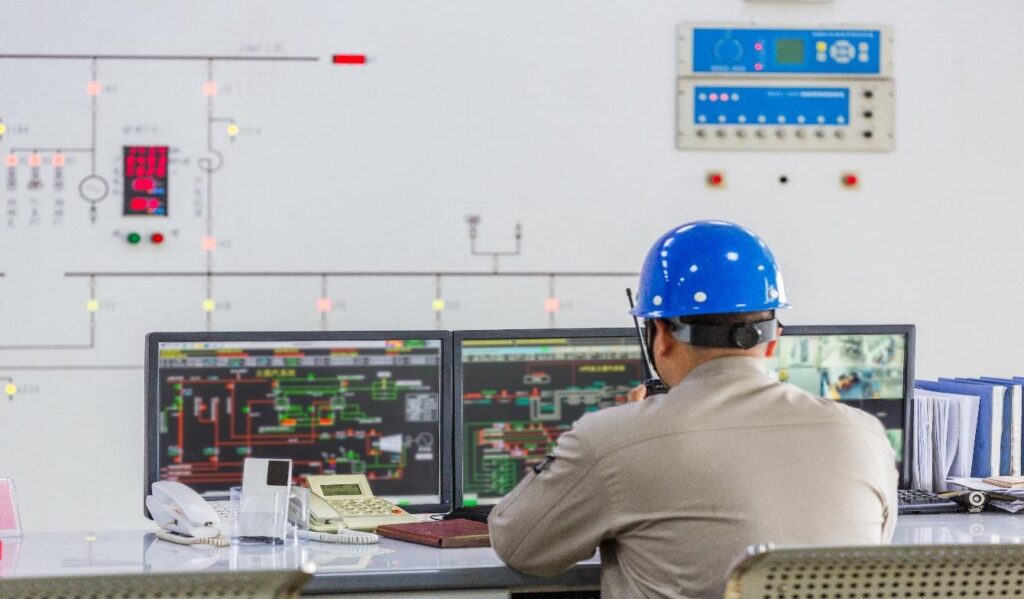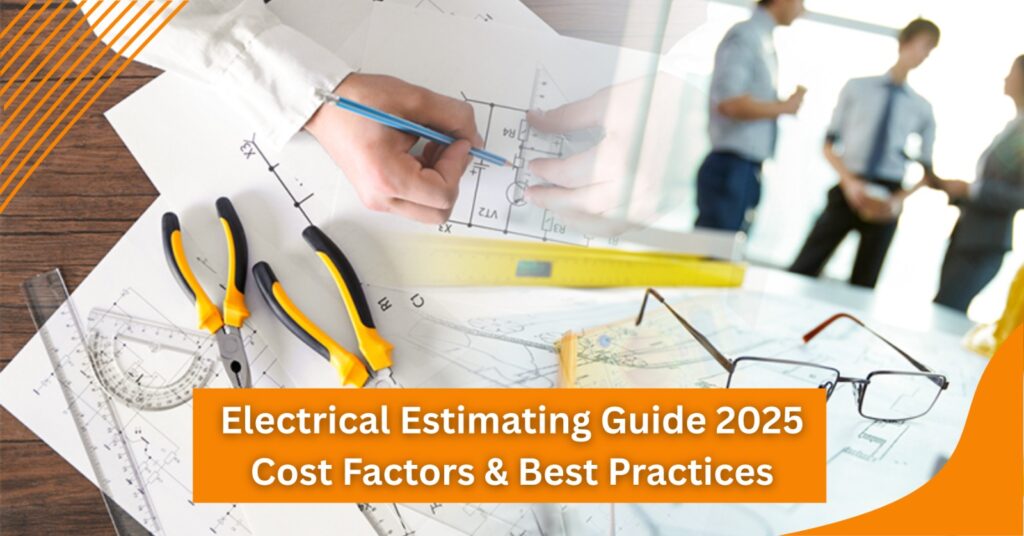Have you been in a situation where you put hours into a project plan and then lost the bid because your numbers were off by a few bucks on wiring or lighting? It’s frustrating. As an electrical contractor in the USA, you know the challenges. Tight deadlines, rising material prices, and clients expecting spot-on quotes every time. In 2025, with supply chain setbacks and green energy pushes ramping up, accurate electrical estimating isn’t just smart. It’s your ticket to steady work and bigger profits. This blog breaks it all down in plain terms. It covers how to estimate electrical work from scratch, what really drives up bid pricing, and simple tricks to keep your numbers tight.
Mapping Out the Scope: What Goes Into Electrical Estimating
Every solid estimate starts with knowing exactly what you’re quoting. Skip this, and you’re guessing on costs, which leads to surprises nobody wants. For electrical takeoff USA projects, focus on these core pieces:
- Wiring and Cabling: This is the backbone. For running Romex or MC cable through walls and ceilings in 2025, measure linear feet carefully, average 500-1,000 feet for a home remodelling.
- Conduits and Raceways: Pipes (PVC or EMT) protect wires from damage. A conduit material takeoff is the counting of bends, couplings, and straps. Factor in 10-15% extra for site mishaps.
- Lighting Fixtures and Controls: Lighting cost can vary from recessed cans to smart LEDs. LEDs are cheaper now, at least 20% down since 2023. However, adding dimmers and sensors for that modern touch clients pay for.
- Panels and Distribution: Breaker boxes, subpanels, don’t forget grounding and surge protection. These eat up 15-20% of your total budget on bigger projects.
- Labor and Installation: Hands down the biggest part of the budget. It’s not just pulling wire. It’s testing, troubleshooting, and code checks.
Nailing the scope means using blueprints or site walks to list every outlet, switch, and run. Tools like digital takeoffs save time by changing weeks into a day’s work. Therefore, you can spend your time on new leads.
Breaking Down Cost Factors: What’s Driving Prices in 2025
Costs aren’t static. They vary with markets and tech. For electrical contractor estimating, here’s what to watch:
- Materials: It leads the pack at 40-50% of bids. Copper prices stabilized around $4.50 per pound this year, but aluminium alternatives cut wiring costs by 30% for long hauls. Steel conduits? Up 8% due to tariffs, so shop in bulk from reliable USA suppliers to dodge delays.
- Overhead: It sneaks in, too, permitting an average $500-2,000 per project, depending on your state. Tools and trucks add another 10%. Poor planning dumps 5-10% of materials in landfills.
- Labour: Labour costs $60-120 per hour nationwide, but skilled sparks with EV charger certs command top dollar. Fuel for your crew? Gas at $3.80/gallon means routing jobs efficiently or eating losses.
- Volatility: What impacts electrical bid pricing most? Volatility. A late material delivery can increase costs by 15%, while incentives such as the Inflation Reduction Act knock 30% off solar-integrated lighting setups.

Labor Hours: Standards That Keep You on Track
Guessing labour is a bid-killer. Instead, rely on proven standards to keep your estimates accurate. When using U.S. wiring cost calculator tools, use benchmarks from trusted industry sources like NECA to stay on target. Basic residential wiring took almost 0.5-1 hour per 100 feet, commercial conduit installs took 1.5-2 hours per 100 feet, factoring bends and pulls. Lighting can take 0.75 hours per fixture and 0.25 hours for finishing.
Regional tweaks matter big time. In the Northeast, like New York, wages can be 20% higher, that is $90/hour due to union rules and cold-weather slowdowns. Head South to Texas, and it’s $70/hour with faster paces from milder weather. West Coast? California’s green codes add 10-15% time for low-voltage integrations. Build in buffers for up to 15% for unknowns like hidden joists.
Step-by-Step: How to Estimate Electrical Works Like a Pro
Ready to build your own electrical takeoff in the USA? Here’s a step-by-step procedure:
- Gather Docs: Complete your documents that are blueprints, specs, and site photos. Mark up digitally for speed.
- Quantity Takeoff: Count everything from feet of wire to boxes of fittings. Use apps for auto-calculations on conduit material takeoff.
- Price It Individually: Multiply quantities by unit costs. Wiring at $1.20/foot for 12/2 NM-B. Lighting at $15-50 per LED troffer.
- Add Labor: Hours, times rate and travel. For a 2,000 sq. ft. office, that’s 80-100 man-hours.
- Layer Overhead and Profit: 15-25% overhead, 10-20% markup. Adjust for risk, high-end clients often mean tighter profit margins.
- Review and Adjust: Double-check against past jobs. What if the copper price increases? Have contingency lines ready.
This method cuts errors by 25%, per recent AGC reports. It’s straightforward, but consistent practice makes it second nature. Skip steps, and you’re back to rework nightmares.
Automation and Software: Your Secret Weapon for Accuracy
In this tech era (2025), software like Stack or Procore cuts estimating time by 40%. Why? Auto-counts for lighting cost estimates, 3D modeling for conduit runs, and real-time pricing did this fast.
For MEP estimating, integrations with BIM tools spot clashes before bids, saving 10% on change orders. Free trials abound, but pick ones with mobile access for field tweaks. It’s not tech for tech’s sake. It lets you focus on client chats, not math. Start small, plug in one job, and compare. It ensures competitive bids and clients’ trust.

Best Practices: Tips to Bid Smarter, Not Harder
Winning bids isn’t luck. It’s a habit. Here’s what top electrical estimating services in the USA pros do for competitive bids:
- Build a Cost Database: Track the real costs from every project and update it every quarter. It keeps your U.S. wiring cost calculator sharp and reliable.
- Plan for Scenarios: Test “what if” bids, like adding 10% for potential rainy-season delays to stay prepared and protect your margins.
- Get Client Input Early: Talk timelines and possible upgrades upfront. It often reveals hidden needs, like adding EV charging readiness or smart home features.
- Add Green Options: Include energy-efficient choices in your quotes. Rebates can cover up to 20% of lighting costs and make your proposal stand out.
- Train Your Team: Hold quick huddles to share best practices and standards. A well-informed team means fewer mistakes and punch lists.

Conclusion
Electrical estimating in 2025 demands precision amid change. From scoping wiring and conduits to balancing labor across regions, every piece fits into stronger bids. You’ve got the steps to estimate work confidently, spot pricing pitfalls, and lean on tools that make it easier. The real win? Turning frustration into flow, less rework, more revenue. Stay adaptable, update your database, test new software, and always eye those long-tail wins like “precise electrical takeoff for commercial retrofits in the USA.” You’re not just bidding. You’re building a business that lasts. Keep these insights handy, tweak them to your workflow, and step into the new year ready to lead.
Ready to Nail Your Next Bid? Act Now with Expert Support. Don’t let estimating headaches slow you down. Partner with ALM Estimating for fast and accurate electrical takeoff USA services tailored to your project
FAQs:
Q1. How do I start estimating electrical works for a new project?
Begin with a thorough review of plans and specs to list all elements like wiring runs and fixtures. Then, perform a detailed quantity takeoff using digital tools for accuracy. Price materials at current rates, add labor based on standards, and include 15% for overhead. This step-by-step keeps things organized and reduces surprises.
Q2. What are the main factors impacting electrical bid pricing in 2025?
Material fluctuations, like copper at $4.50/lb, top the list, followed by labor rates varying by region ($60-120/hour). Add permits, fuel costs, and incentives for green tech, which can cut 20-30%. Track weekly to adjust bids proactively and stay competitive.
Q3. How can I calculate accurate lighting cost estimates?
Measure fixtures needed from drawings, then multiply by unit prices. LEDs run $15-50 each. Factor installation at 0.75 hours per unit, plus controls like dimmers ($20-100). Use software for bulk calcs and add a 10% buffer for tweaks, ensuring bids reflect real expenses.
Q4. What’s involved in a conduit material takeoff?
Count linear feet of pipe, plus fittings like elbows and straps, and aim for 10% overage. Specify types (PVC vs. EMT) based on codes. Tools auto-generate lists from plans, speeding up what used to take days and minimizing waste on site.
Q5. How do regional price variations affect electrical contractor estimating?
East Coast jobs cost 20% more in labor due to unions; Southern states save on milder weather. Adjust rates accordingly, use NECA benchmarks, and local supplier quotes. This keeps your USA-wide bids fair and winnable.
Q6. What labor hour standards should I use for wiring installations?
For residential, plan 0.5-1 hour per 100 feet; commercial doubles that with pulls. Customize from your job logs and add 15% for variables like attics. Consistent tracking builds a reliable wiring cost calculator for USA models over time.
Q7. How does automation improve electrical estimating accuracy?
It auto-detects quantities in blueprints, pulls live prices, and flags errors, cutting time by 40%. Integrations with BIM prevent clashes, saving 10% on changes. Start with affordable options like Stack to see quick gains without a steep learning curve.
Q8. Why include profit margins in every electrical bid?
Margins (10-20%) cover risks and growth, ensuring sustainability. Without them, small overruns wipe out earnings. Tailor based on job size, higher for complex MEP setups, and review post-job to refine for future wins.
Q9. How can I handle unexpected cost increases during a project?
Build 5-10% contingencies into bids and document changes with photos. Communicate early with clients via addenda. Strong scopes upfront prevent most hikes, keeping relationships solid even when prices shift.
Q10. What’s the best way to make my bids stand out to clients?
Highlight value-adds like energy savings or fast timelines, backed by detailed breakdowns. Include visuals like cost charts and green options. Personal touches, like quick follow-ups, turn numbers into partnerships that land repeat business.
